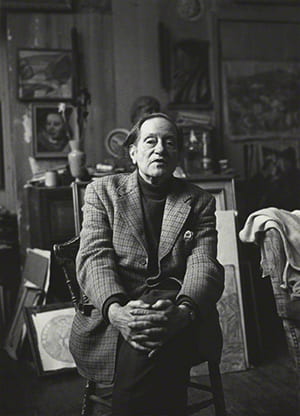
Duncan Grant
 Painter and Designer (1885-1978)
Painter and Designer (1885-1978)
Duncan Grant was born in the family ancestral home at Aviemore on 21st January 1885 but spent his early years in India and Burma, where his father’s regiment was stationed. Between 1894 and 1899 he attended Hillbrow School, Rugby where his talent for art was encouraged. He was introduced to Japanese prints and the work of Edward Burne-Jones and awarded Ruskin’s The Elements of Drawing as a prize for his art. At fourteen he entered St Paul’s School and again won prizes for his art. Due to his poor academic ability he left early and, in 1902, began to study full time at Westminster School of Art. Four years later he spent a year in Paris studying at the Académie de La Palette before returning to London to attend the Slade School of Art.
With a move to 21 Fitzroy Square towards the end of 1909, Grant swiftly became a central figure within the Bloomsbury Group. Roger Fry persuaded Grant to become a co-director of the Omega Workshops, which opened nearby in 1913. Grant played a leading role in the whole venture, from painting their signboard to producing designs for textiles, embroideries and ceramics, as well as wooden toy animals and a dolls house. Not only did Grant benefit financially from his involvement with the Omega Workshops it allowed him to experiment with all kinds of decoration, including costumes and scenery for the theatre.
As part of a project to promote good design, Clarice Cliff commissioned Grant in 1934 to design a dinner service that featured in the ‘Modern Art for the Table’ display at Harrods in that same year. Grant also designed a unique dinner service for Kenneth Clark, Director of the National Gallery, who featured Grant in his Penguin Modern Painters series. The following year Grant, together with Vanessa Bell, accepted a commission to paint decorative panels for the new Cunard liner, RMS Queen Mary but the directors felt that his stylised figures did not fit with the aesthetic found elsewhere on the ship, and his designs were rejected. Around this time Grant exhibited a poster in the ‘Pictures for Advertising’ exhibition (1934) and a textile design at the RA/RSA British Art in Industry exhibition (1935). A few years later he was appointed a Royal Designer for Industry (RDI) for his work with printed textiles (1941). Although Allan Walton, who had been made an RDI the previous year, promoted the artist’s textile designs Grant was disappointed that this distinction did not secure more commissions for his fabric designs. When Walton became Director of the Glasgow School of Art he invited Grant to come to the school in 1944 to talk to the students and assess their work.
During the course of the Second World War the War Artists’ Advisory Committee (WAAC) gave Grant a short term contract to draw naval subjects. He joined the Home Guard but was still able to carry out a commission for a decorative scheme for Berwick church in Sussex (1943) and, with Vanessa Bell, to arrange a touring exhibition for CEMA called ‘Designs by Various Artists for Decoration in the Theatre’.
At the end of the war Grant turned his hand to book illustration although he still continue to paint murals with Vanessa Bell, including one at the exit to the Shop Window section of the Britain Can Make It exhibition (1946). He was invited by the Arts Council to submit a canvas for their exhibition, ’60 Paintings for ‘51’, planned to coincide with the Festival of Britain.
As an RDI Grant agreed to act, with another mural artist Anna Zinkeisen RDI, as an assessor for the RSA’s 1949 competition for a painted wall panel for the entrance hall of a new office block in Dundee. He designed the flower vases used for the first RDI evening reception held in 1950 and attended by HRH Princes Elizabeth (later HM Queen Elizabeth II) as President of the RSA.
Duncan Grant died at the age of 93 on 9 May 1978.
Britain Can Make It Exhibition Catalogue 1946
- Group D: Books and Printing – item 118
- Designers – page 238
Further reading
Frances Spalding, Duncan Grant (London: Chatto & Windus, 1997)
Image © National Portrait Gallery. Photographer: Godfrey Argent (1968). NPGx166064.
